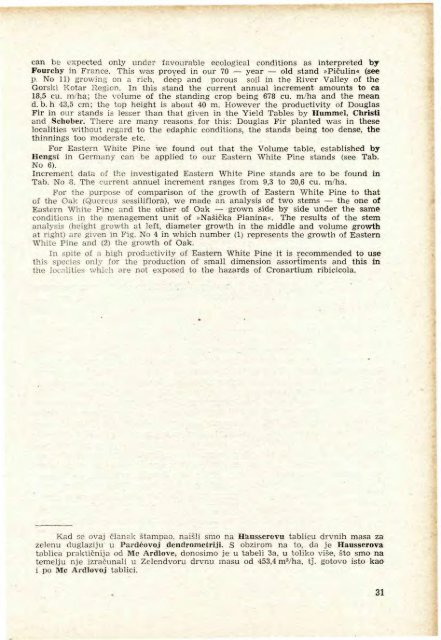Å UMARSKI LIST 1-2/1962
Å UMARSKI LIST 1-2/1962
Å UMARSKI LIST 1-2/1962
You also want an ePaper? Increase the reach of your titles
YUMPU automatically turns print PDFs into web optimized ePapers that Google loves.
can be expected only under favourable ecological conditions as interpreted by<br />
Fourchy in France. This was proyed in our 70 — year — old stand »Pičulin« (see<br />
p. No 11) growing on a rich, deep and porous soil in the River Valley of the<br />
Gorski Kotar Regien. In this stand the current annual increment amounts to ca<br />
18,5 cu. m/ha; the volume of the standing crop being 678 cu. m/ha and the mean<br />
d. b. h 43.5 cm; the top height is about 40 m. However the productivity of Douglas<br />
Fir in our stands is lesser than that given in the Yield Tables by Hummel, Christi<br />
and Schüber. There are many reasons for this: Douglas Fir planted was in these<br />
localities without regard to the edaphic conditions, the stands being too dense, the<br />
thinnings too moderate etc.<br />
For Eastern White Pine we found out that the Volume table, established by<br />
Hengst in Germany can be applied to our Eastern White Pine stands (see Tab.<br />
No 6).<br />
Increment data of the investigated Eastern White Pine stands are to be found in<br />
Tab. No 8. The current annuel increment ranges from 9,3 to 20,6 cu. m/ha.<br />
For the purpose of comparison of the growth of Eastern White Pine to that<br />
of the Oak (Quercus sessiliflora), we made an analysis of two stems — the one of<br />
Eastern White Pine and the other of Oak — grown side by side under the same<br />
conditions in the menagement unit of »Našička Planina«. The results of the stem<br />
analysis (height growth at left, diameter growth in the middle and volume growth<br />
at right) are given in Fig. No 4 in which number (1) represents the growth of Eastern<br />
White Pine and (2) the growth of Oak.<br />
In spite of a high productivity of Eastern White Pine it is recommended to use<br />
this species only for the production of small dimension assortiments and this in<br />
the localities which are not exposed to the hazards of Cronartium ribicicola.<br />
Kad se ovaj članak štampao, naišli smo na Häusserovu tablicu drvnih masa za<br />
zelenu duglaziju u Pardeovoj dendrometriji. S obzirom na to. da je Hausserova<br />
tablica praktičnija od Me Arđlove, donosimo je u tabeli 3a, u toliko više, što smo na<br />
temelju nje izračunali u Zelendvoru drvnu masu od 453,4 m 3 /ha, tj. gotovo isto kao<br />
i po Me Arđlovoj tablici.<br />
31
















